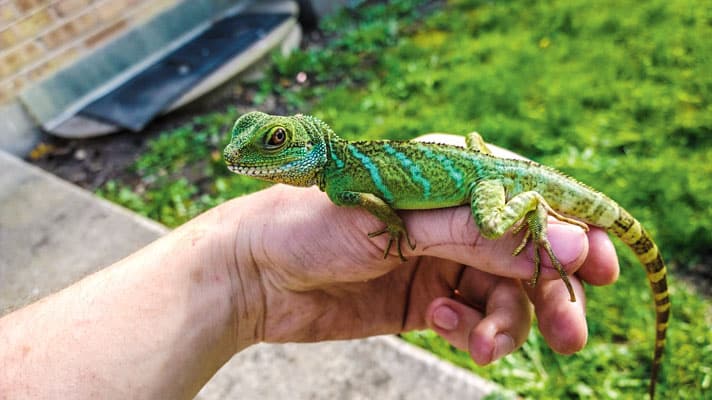With this article, I introduce the rigors and techniques that have worked as a successful water dragon keeper and breeder for more than a decade.
The range of the Chinese water dragon (Physignathus cocincinus; also known as the Asian or green water dragon) includes mainland China, some of the islands of Indonesia, much of southeast Asia, Thailand, Cambodia and Vietnam. The reason for its common name is that this nearly neon-green lizard is well known for living its entire life near flowing creeks, small ponds and other bodies of fresh water in forested areas. It’s also arboreal, frequently lounging on tree limbs high above water. When threatened, a water dragon may nose-dive straight down into the water and remain hiding there until the perceived threat has passed (I have heard of durations of up to 25 minutes underwater).
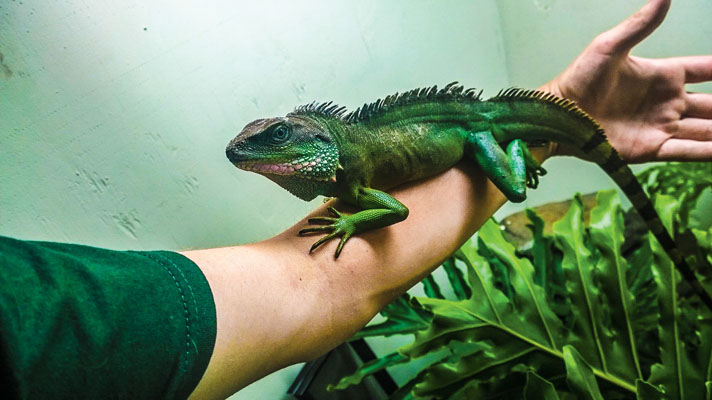
Ryan Chermel
The water dragon earns its common name, as wild dragons can usually be found near flowing creeks, ponds and other bodies of water.
Chinese Water Dragon Looks And Appearance
A healthy, mature male water dragon is a sight to see. Bright green with black speckling, along with a throat that is blue, red, orange, yellow, or a combination of these colors makes the water dragon one of the most beautiful lizards available to hobbyists. Females, too, boast a very nice emerald green coloration with blue striping along the back. Females also boast bright pink throats.
Juvenile water dragons begin to exhibit an orange-yellow hue beneath the two front “armpits,” and the head crest and spines along the back will become enlarged in males. The dark streak behind their eyes may get darker, and the throats of males turn from white to a blue or orange color, depending on individual genetics. Females retain white throats through the sub-adult stage; even juveniles are sexually dimorphic. A female’s head crest appears underdeveloped compared to a male’s, and its spikes are less prominent, appearing stubbier than a male’s sharper spikes.
The water dragon, like many other agamid lizards, has an incredibly long tail. It can make up nearly two-thirds of a dragon’s total body length, which is generally just over 3 feet for males and 2½ to 3 feet for females. The tail is used for balance when running, steering when swimming, and as a counterweight when climbing, helping water dragons to maintain balance among the branches they gravitate toward. A water dragon may also whip its tail in defense, much like a green iguana, although these lizards are more inclined to run.
The legs of a water dragon are built to climb. The front legs are slim and more defined, used for gripping and lifting the dragon up and into foliage, while the powerful rear legs not only aid in climbing but also allow a water dragon to run bipedally. The feet consist of five long toes, the longest being the middle toes on the hind feet, with needlelike claws that are curved at their ends. If you’re going to handle an adult water dragon, I recommend gloves to prevent potentially painful scratches. Claws may harbor bacteria, too, which can result in scratches becoming infected if preventive measures (gloves, washing, etc.) are not taken.
Water dragons are prevalent in the reptile-keeping hobby, though, unfortunately, many are wild-caught specimens that are stressed out and skinny, sometimes with noses rubbed down to the bone. Traditional pet stores do not usually have the means to properly care for water dragons, due to space constraints and, in some cases, a lack of employee knowledge. Many people who attempt to care for a water dragon will find it difficult to find good sources of information, as I did when first starting out. With this article, I will introduce you to the rigors and techniques that have worked for me as a successful water dragon keeper and breeder for more than a decade.
Chinese Water Dragon Enclosure Setup
Have your new water dragon’s enclosure set up before you come home with your new pet. This will help it to adjust to its new surroundings. Also avoid handling it for at least a month while it’s getting acclimated; otherwise, you risk causing stress, which could lead to a refusal to eat.
After a month or so, you may begin handling your water dragon, first by offering it food in the palm of your hand. As it approaches the food and takes it, do not grab at the dragon, but slowly lift it from beneath and let it climb onto your palm. If it tries to run away, again, do not grab, but let it warm up to you slowly over a period of time. A little bit of work every day will help to build trust between you and the animal.
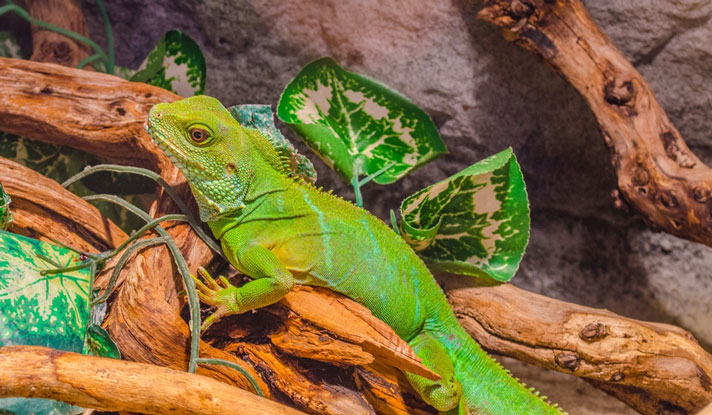
trabantos/Shutterstock
When it comes to housing, it is important to consider the animal's natural habitat.
It is also important to take your new water dragon to a veterinarian who specializes in exotics, to make sure that it is healthy and not riddled with parasites. Remember, water dragons are imported animals under most circumstances, and receiving proper vet treatments for your dragon right away will make the acclimation period all the more enjoyable for the two of you.
A water dragon hatchling may be kept in a 20-gallon fish tank, but I recommend being ready to upgrade quickly and away from glass because of water dragons’ inability to perceive glass, coupled with their propensity to run into it, or rub their noses against it constantly. Water dragons have a reputation for beating themselves up in glass terrariums. It is almost impossible to prevent a water dragon from nose rubbing profusely, unless you create a visual barrier around the front of the glass so they cannot see through it. Even with that, a determined water dragon may continue to jump into the glass above the barrier, or try to dig down into the substrate to get under it. When they smash their faces because of this relentless behavior, irreversible damage to their snouts may result, as well as infection, mouth rot, jaw loss and other injuries that could cause a dragon to stop eating, become ill or even die.
Custom-made wooden enclosures with screen fronts work well for my juveniles, sub-adults and adults. They tend to reduce the nervousness that regularly comes with wild-caught dragons because they feel safer in an enclosed setting.
For a dragon that is 1 foot long, I provide a 2-foot-square enclosure; for one that is 2 feet long, the enclosure measures 3 feet long, 2 feet wide and 3 feet tall, and the minimum size I enclosure I use with adults is 3 square feet. Again, that’s the very minimum; larger is even better.
Once water dragons are 4 months old, a pair is the most that you will likely be able to house together, as water dragons can be very territorial. Hand waving, tail whipping, throat puffing and head bobbing is not uncommon. In my experience, housing multiple females together with one male also tends to breed hostility, especially at feeding time, when they may bite one another fighting over food, or the dominant member of the group chases the others away, leading to stressed animals. I would not recommend any enclosure smaller than 6-foot-square for a trio of adult water dragons, and even this may not alleviate all hostility.
When it comes to housing, it is also very important to consider the animal’s natural habitat. A simple search into weather patterns from their localities will tell you that water dragons enjoy morning humidity around 75 to 80 percent, which can be facilitated by a misting system that sprays frequently for the first few hours of the day. Or you can mist by hand. By the evening, a humidity range between 50 and 60 percent is more than ample for a water dragon to feel content in the enclosure.
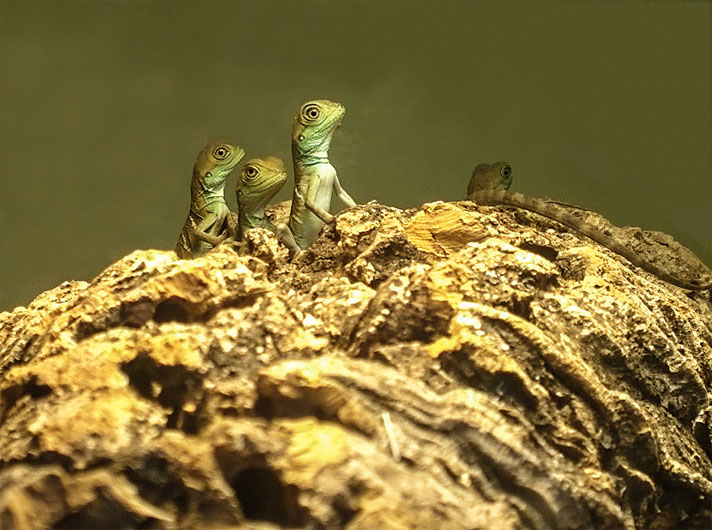
Ryan Chermel
Water dragons require UVB lighting.
Temperatures need to be warm. For babies, a basking spot of 95 to 101 degrees Fahrenheit is ample, and an ambient temperature for the tank should be in the mid 80s with a cool side ranging between 77 and 82 degrees during the day. At night, temperatures may dip to the low 70s, but not any cooler than that because dragons could become sluggish and less likely to eat regularly. Plus, water dragons seem prone to respiratory infections that may be brought on by cooler temperatures.
A basking spot of 120 degrees is ideal for juvenile and adult water dragons, and the ambient temperatures, as well as those at the cooler end of the enclosure, can be as previously described for hatchings. Basking spot heat can be provided by heat emitters or basking bulbs. Another interesting feature of the water dragon is the pineal gland, or “third eye,” that helps to detect fluctuations in light and I suspect this also helps water dragons to find the perfect basking spot.
Water dragons require UVB lighting, and it must be provided to prevent disease and to ensure that pet water dragons grow properly and are able to function regularly.
As for décor, provide lots of vegetation (either artificial or nontoxic live plants) along with many branches and climbing vines to simulate the natural water dragon environment. A waterfall or drinking dish should be maintained in any water dragon enclosure, as well. Keep water bowls clean, possibly using a filtration unit. Cleanliness is mandatory, as water dragons constantly defecate in their water bowls.
Chinese Water Dragon Food Items
Water dragons are omnivores, and healthy specimens can be voracious eaters. Their diet as hatchlings will consist of traditional feeder insects, such as pinhead crickets, every day and appropriately sized mealworms once or twice a week. I offer these to water dragons until they are about 3 to 5 months old.
Once they’re that age, start offering salads comprised of leafy greens, such as mustard and collard, which are high in vitamins and calcium. Both are crucial for a young water dragon’s growth and color maturity. Of course, life would be perfect if they actually ate the vegetables. Instead, when you first begin offering them, your water dragon will most likely kick the veggies out of the food dish and ignore them. This can be frustrating, but do not fret—there’s a way to get your dragons to suck down their greens. Try smearing banana on them, as the sweet smell of fruit is sometimes enough to tempt a water dragon to gobble down the greens, or it leave you with a gooey mess of sticky greens stuck to the sides of the enclosure and mashed into the substrate.
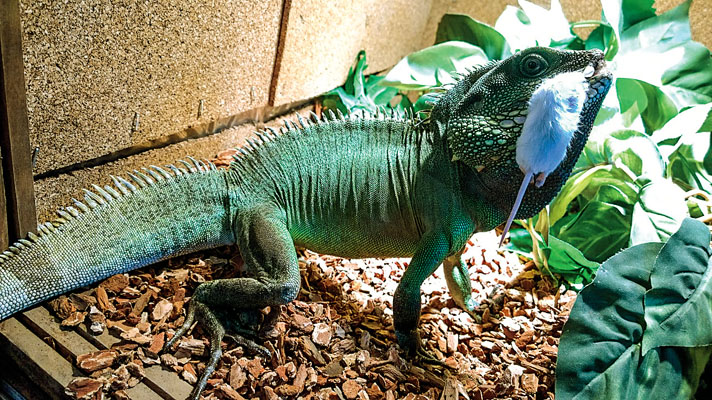
Ryan Chermel
Chinese water dragon eating a mouse.
Larger crickets, ⅜ to ⅝-inch size, and occasional wax worms and small roaches may be added to the water dragon diet once they’re 3 to 5 months old. Water dragons will then go through a growth spurt between 5 months and 1 year of age. In this juvenile stage, start offering fruits, such as blackberries, blueberries, raspberries, thin slices of banana and peach, along with grapes, as a treat once or twice a week. An occasional pinky mouse may also be offered once or twice a month during this stage of rapid development and growth.
It is important to note here that water dragons do not maintain their weight very well. They are very active lizards when housed properly, and tend to burn calories almost as quickly as they consume them. Gut-loading prey items is a must, as is feeding water dragons twice a day, once in the morning and a smaller meal in the evening. Adult dragons can be fed small mice, adult crickets, large Dubia roaches, superworms, nightcrawlers and anything else they can get their mouths on.
Asian or Green Water Dragons Are Aggressive Breeders
When housed in optimal conditions, water dragons may breed all year round, even up to the point that a female deposits a clutch every month or two. Of course, this can prove deadly to a female dragon because all of the calcium in her diet will go toward the developing eggs, as will all of the other nutrients and fat that she takes in. Also, if a female develops metabolic bone disease due to a lack of calcium in her system, yet continues to be bred, she will become increasingly likely to become egg bound, and her ability to walk and climb could be reduced almost to the point where the dragon is nearly immobile.
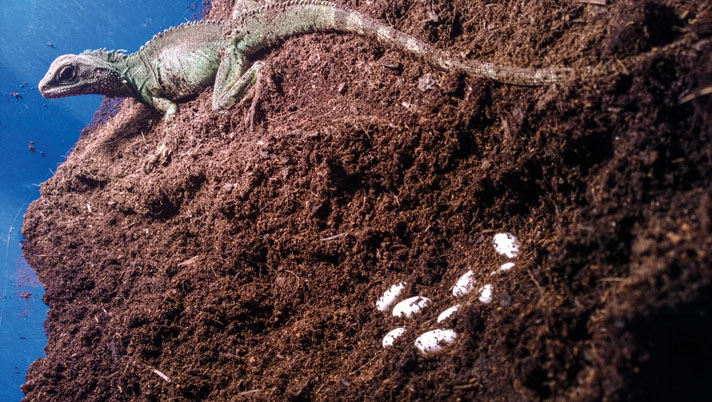
Ryan Chermel
Female Chinese water dragon with clutch of eggs.
If a pair is reproducing at such a prolific rate, it is crucial that you separate them between breedings so the female may recover and regain a healthy weight. Failure to do so will inevitably lead to serious consequences. Damaged crests and other injuries resulting from overbreeding may also become infected if they are continuously reopened due to frequent breeding without sufficient intervals (remember, water dragons can be aggressive, especially when in breeding mode).
Breeding is best left to experienced keepers who will recognize that a healthy water dragon is becoming unhealthy, and under those conditions, the breeding of water dragons can be quite rewarding (even if not financially, due to the relatively low market value of water dragons due to the many wild-caught imports that flood the market).
Clutch sizes are normally 10 to 18 eggs, with the average yield, in my experience, about 13 viable and two infertile eggs per a clutch. I’ve noticed that female water dragons will most likely not lay eggs in the presence of the male, likely because when her tail lifts to begin laying her eggs, the male may see this as a sign of her submission and he will aggressively try to court her, putting an end to her attempts to deposit her eggs. A separate enclosure, such as a temporary tub or bin, should be set up and ready to accommodate the needs of a female about to lay eggs. Inside, 6 to 12 inches of warm, moist soil is just what the doctor ordered, and you will see the gravid female sifting through and kicking up the dirt prior to laying, a process that can last for hours.
Eventually a spot will be chosen and eggs will be laid. Remove the eggs for incubation. I use vermiculite as an incubation medium, saturating the bottom layer until it appears clumped, and then adding another 2 to 3 inches on top of that. The top layer of vermiculite is misted lightly once, before the eggs are placed into it. After placing the eggs into the incubation medium, I pack them in with some additional dampened coco fiber, leaving the top half of the eggs exposed.
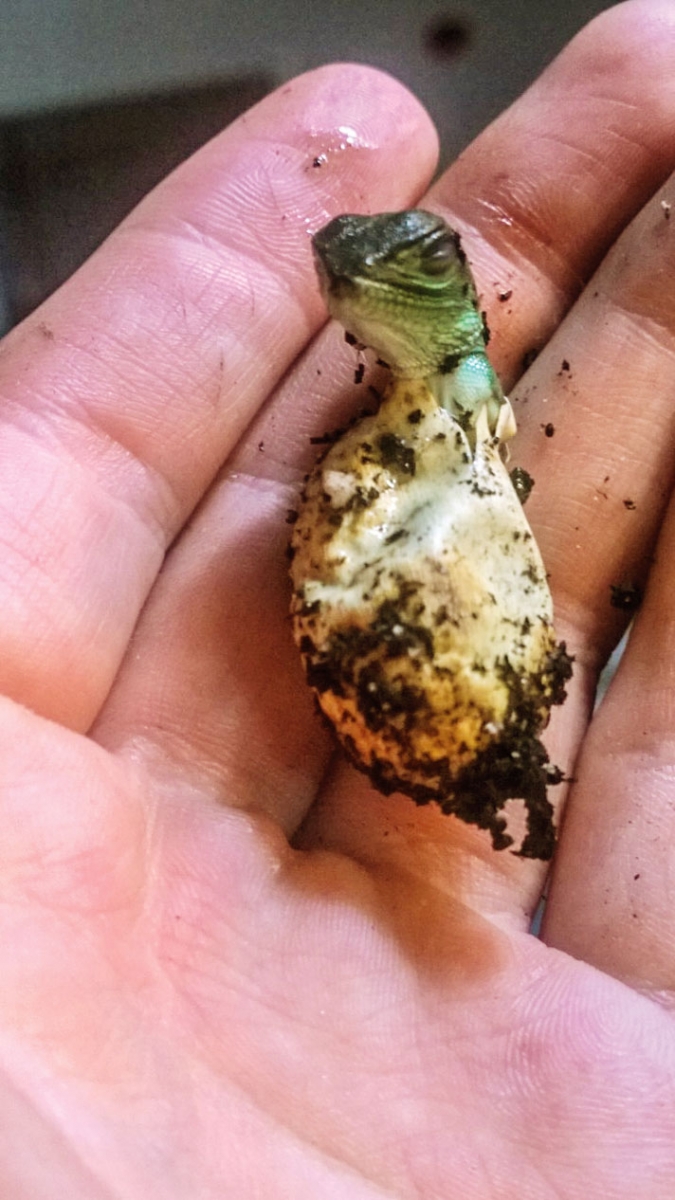
ryan chermel
A Chinese water dragon hatching in author's hand.
Temperature fluctuations in the incubator can result in egg failure, deformities or death shortly after the young hatch. A good incubation temperature range is 85 to 88 degrees. Use a digital hygrometer to measure the humidity; a range of 70 to 80 percent is key for healthy water dragon eggs. Humidity below 65 percent could result in eggs collapsing.
Approximately 60 to 75 days later, a clutch of babies will appear in your incubator. Hatchlings are about 2 inches in length snout to vent, up to a total length of 8 inches, when they first emerge from their eggs to take on the world.
Just because they are babies does not mean that they are sweet. When removing baby water dragons from the incubator, do so with caution, as they are ready to run right out of the egg and into the wilderness that is your home. Often, baby water dragons will also bite and alligator roll, neither of which, in all honesty, has much effect—you can barely feel the bite of a hatchling. That said, to help avoid stressing them out, I leave baby water dragons in the incubator for about an hour after they hatch so that they are able to soak up remaining nutrients from the egg. Later, about three days after they arrive on the scene, baby water dragons will start chowing down on pinhead crickets and running rampant. They are truly little raptors from the start.
Ryan Chermel has worked with many reptiles species, from both Chinese and Australian water dragons to Hydrosaurus, basilisks and more. Not a day goes by when he does not learn something from them, and he considers it a joy and privilege to be able to keep and work with such marvelous creatures.

